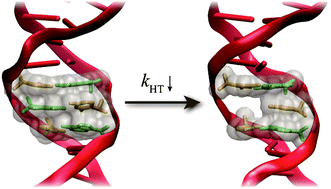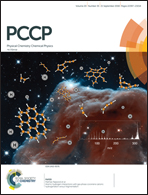How abasic sites impact hole transfer dynamics in GC-rich DNA sequences
Abstract
Changes in DNA charge transfer properties upon the creation of apurinic and apyrimidinic sites have been used to monitor DNA repair processes, given that such lesions generally reduce charge transfer yields. However, because these lesions translate into distinct intra and extrahelical conformations depending on the nature of the unpaired base and its DNA context, it is unclear the actual impact of such diverse conformations on charge transfer. Here we combine classical molecular dynamics, quantum/molecular mechanics (QM/MM) calculations, and kinetic Monte Carlo simulations to investigate the impact of abasic sites on the structure and hole transfer (HT) properties of DNA. We consider both apurinic and apyrimidinic sites in polyG and polyGC sequences and find that most situations lead to intrahelical conformations where HT rates are significantly slowed down due to the energetic disorder induced by the abasic void. In contrast, the presence of an unpaired C flanked by C bases leads to an extrahelical conformation where stacking among G sites is reduced, leading to an attenuation of electronic couplings and a destabilization of hole states. Interestingly, this leads to an asymmetric HT behavior, given that the 5′ to 3′ transfer along the G strand is slowed down by one order of magnitude while the opposite 3′ to 5′ transfer remains similar to that estimated for the reference polyG sequence. Our simulations thus suggest that electrochemical monitoring of the DNA repair process following changes in charge transfer properties can miss repair events linked to abasic sites adopting extrahelical conformations.



 Please wait while we load your content...
Please wait while we load your content...